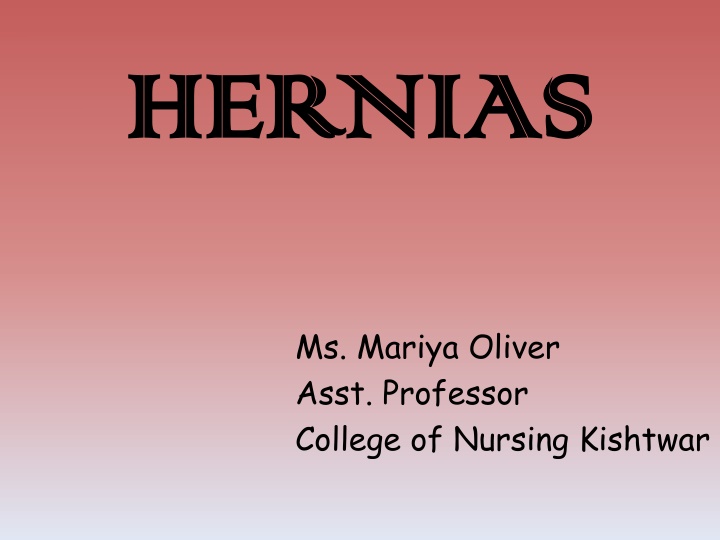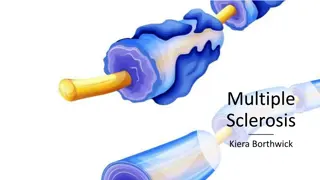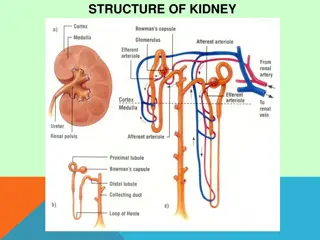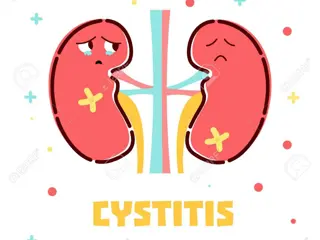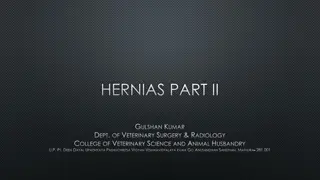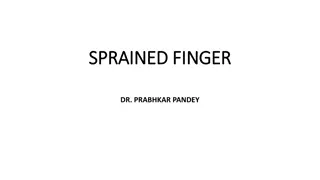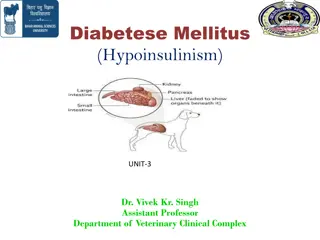Hernias - Causes, Symptoms, and Treatment
A hernia is the protrusion of an organ through the wall of a cavity. Learn about hernia types, symptoms, risks, and classifications in this informative guide with images.
Download Presentation

Please find below an Image/Link to download the presentation.
The content on the website is provided AS IS for your information and personal use only. It may not be sold, licensed, or shared on other websites without obtaining consent from the author.If you encounter any issues during the download, it is possible that the publisher has removed the file from their server.
You are allowed to download the files provided on this website for personal or commercial use, subject to the condition that they are used lawfully. All files are the property of their respective owners.
The content on the website is provided AS IS for your information and personal use only. It may not be sold, licensed, or shared on other websites without obtaining consent from the author.
E N D
Presentation Transcript
HERNIAS HERNIAS Ms. Mariya Oliver Asst. Professor College of Nursing Kishtwar
On a piece of clothing, a loose seam will be prone to tear; make it too tight and it will restrict movement.
What is a hernia? What is a hernia? A hernia is the protrusion of an organ or the fascia of an organ through the wall of the cavity that normally contains it. By far the most common hernias develop in the abdomen, when a weakness in the abdominal wall evolves into a localized hole, or "defect", through which adipose tissue, or abdominal organs covered with peritoneum, may protrude.
Hernias by themselves usually are harmless, but nearly all have a potential risk of having their blood supply cut off (becoming strangulated). If the blood supply is cut off at the hernia opening in the abdominal wall, it becomes a medical and surgical emergency.
Constituents of hernia Constituents of hernia Hernial ring Hernial sac Hernial contents
Classification or characteristics of Classification or characteristics of hernias hernias I. Based on Location : External hernia Inguinal hernia, Umbilical hernia. Internal Hernia Diaphragmatic hernia. II. Based on functional alterations: Reducible Irreducible Incarcerated hernia, strangulated hernia
Cont. Cont . III. Based on hernial contents i) Enterocoele intestines ii) Vesiculocoele urinary bladder IV. Based on cause i) Congenital anatomical variations ii) Acquired trauma
CONT. CONT . V. Complete and Incomplete hernia. VI. Intraparietal hernia. VII. Bilateral or Unilateral hernia.
TYPES OF HERNIAS TYPES OF HERNIAS http://upload.wikimedia.org/wikipedia/commons/1/11/Inguinalhernia.gif Inguinal (groin) hernia Direct inguinal hernia Indirect inguinal hernia
Femoral hernia Umbilical hernia Incisional hernia Spigelian hernia Obturator hernia Epigastric hernia Diaphragmatic hernia
Diaphragmatic hernia Diaphragmatic hernia http://upload.wikimedia.org/wikipedia/commons/f/fe/Hiatalhernia.gif
OTHER HERNIAS OTHER HERNIAS 1. Littre's hernia. 2. Lumbar hernia (Bleichner's Hernia) Petit's hernia + Grynfeltt's hernia 3. Maydl hernia 4. Pantaloon hernia 5. Paraumbilical hernia 6. Perineal hernia
CONT. CONT . 7. Properitoneal hernia 8. Richter's hernia 9. Sciatic hernia 10.Sports hernia 11.Velpeau hernia 12.Amyand's Hernia
ETIOLOGY ETIOLOGY Obesity. Heavy lifting. Coughing. Straining during a bowel movement or urination. Chronic lung disease. Fluid in the abdominal cavity. A family history. If muscles are weakened due to poor nutrition, smoking, and overexertion, hernias are more likely to occur.
SIGNS AND SYMPTOMS SIGNS AND SYMPTOMS Reducible hernia. Irreducible hernia. Strangulated hernia. Others.
PROGRESS OF THE HERNIA PROGRESS OF THE HERNIA OBSTRUCTION
Incarcerated Strangulated
DIAGNOSTIC MEASURES DIAGNOSTIC MEASURES A. History collection B. Physical examination C. Lab investigations D. Cough test E. Valsalva s maneuver F. Imaging studies (MDCT)
COMPLICATIONS COMPLICATIONS Inflammation Irreducibility Obstruction of any lumen, such as bowel obstruction in intestinal hernias Strangulation Hydrocele of the hernial sac Haemorrhage Autoimmune problems
MEDICAL MANAGEMENT MEDICAL MANAGEMENT REDUCIBLE HERNIA IRREDUCIBLE HERNIA
SURGICAL MANAGEMENT SURGICAL MANAGEMENT http://upload.wikimedia.org/wikipedia/en/thumb/0/0a/Hernia_surgery_navy_dr.jpg/220px-Hernia_surgery_navy_dr.jpg
Types of hernia surgeries Types of hernia surgeries Herniotomy. Herniorraphy. Hernioplasty. Laparoscopic surgery. Gastropexy.
NURSING MANAGEMENT NURSING MANAGEMENT 1. Acute pain related to the strangulation of the herniated part and surgical interventions. 2. Imbalanced nutrition, less than body requirement related to nausea, vomiting, and pain. 3. Fluid volume deficit related to presence of hemorrahge, excessive vomiting or fliud accumulation secondary to development of complications. 4. Activity intolerance related to severe pain.
5. Disturbed body image related to protrusion of the body parts through the hernial sac. 6. Anxiety related to severe pain, protrusion of the herniated sac, and outcome of treatment modalities. 7. Deficient knowledge regarding the care to be taken, cause of the disease and the various complications that can arise. 8. Risk for complications, hemorrhage and life threatening situation related to untreated herniated sac. 9. Risk for infection related to protrusion of the body parts to the outside world.
ALLIED SCIENCES ALLIED SCIENCES 1. Herbal medicine. 2. Aromatherapy. 3. Accupressure. 4. Ayurvedic therapy.
JOURNAL ABSTRACT JOURNAL ABSTRACT LAPAROSCOPIC HERNIA REPAIR Vs OPEN HERNIA REPAIR.
THANK YOU THANK YOU
